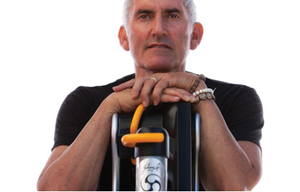By Joan Kent
Johnny G, legendary creator of Spinning and all indoor cycling, as well as Kranking, teaches three elements of training — rhythm, timing and breathing. From him, I borrowed the idea of opening each quarter of training with these concepts, one each day.
Day 1 is about rhythm. This is not following a beat; that”™s actually a matter of timing. It”™s about feeling our own rhythm within, our sense of aliveness. That sense is always there but can be obscured by internal noise — thinking, unfocused attention, and so on. If you can quiet your mind enough to feel it, you”™ll always train with peace and a sense of joy.
Day 2 is about timing. You can explain cadence and work on drills involving cadence changes. I added my own “spin” on it by teaching the close connection between timing and technique. Most mistakes in technique are mistakes in timing.
Technique is important for safety, efficiency (we waste less energy), and the optimal application of power. The mechanics of the pedal or Krank stroke stay essentially the same at any cadence, despite the change in timing. That”™s where cadence work becomes essential. Beatmatch is a terrific tool in cadence drills.
Another timing element is more apparent in movement sequences than in continuous circles — summation of forces. Force summation requires correct timing and sequencing of body segments and muscles throughout the motion. As you may know, combining correct timing and sequencing from large muscles to smaller ones results in maximum force. Before energy is lost from the first — and largest — muscle group, force from the next largest is added to it, continuing through the sequence and creating max force.
Some of you may have analyzed the pedal stroke in such a way that you can give a perfect breakdown of each segment of the pedal stroke in terms of force summation. I”™d love to hear from you on that.
Day 3 is about breathing. Sustained power depends, of course, on oxygen delivery to muscle, and hard training is made possible by efficient breathing. A basic drill is to inhale and exhale with a consistent rhythm, so that the number of breaths matches up with a specific number of pedal strokes in any given time (say, 1 minute). Focus on basic abdominal breathing. Participants have called it “yoga breathing” because inhaling and exhaling both start in the abdomen.
Then run a cadence ladder and note how the match-up of breathing and pedal stroke changes with the increase in power and heart rate.
Another “spin” on breathing comes from my martial arts background. Power is created when we exhale. In karate, the kiai is performed not to shout and make noise, but to generate a moment of great focus of power. In tennis matches, we hear the forceful sound of the players exhaling. Pedaling is continuous, so there”™s no specific moment where we focus power. Instead, we can create one. It can be any part of the pedal stroke that feels like an application of power, but it should be at that same point on each exhalation.
The final breathing drill was another Johnny G technique: uneven breathing. The even rhythm the rider has established between pedal stroke and breathing now changes to make the exhale one pedal stroke shorter (and sharper) than the inhale. (Inhale for, say, 4 down-strokes. Exhale for 3.) This takes practice but is a fantastic way to focus. (I did it for 40 minutes one morning, and my very experienced core knew it had done some serious work.)
At any rate, it”™s a new year. It seems that one great way to start January — even in a class that”™s been running continuously since last year — could be to go back to the beginning of indoor cycling, back to the basics, back to the underlying factors behind the basics, and back to our IC roots.
Then take off from a solid foundation for a great year of training. Happy New Year.
- New Year’s Resolutions: A Sugar Addict’s Survival Guide - April 15, 2024
- Motivation vs. Enthusiasm - October 12, 2023
- Why Exercise Shouldn’t Be Just One Thing - November 9, 2022

Joan,
I just can’t say how pleased I am to see instructors using 2014 as a springboard back in time. Our riders can never get too much from the basics. And the core of what we do is fundamental to their perceived value in returning to the class. Make it too technical, you lose them.
Rhythm, timing and breathing set to some music that ties it all together and viola, happy riders. Add some personal connection and you have the recipe for popular, well attended classes.
I like how all of our riders walk into the class, already having everything they need. No “gear” needed.
Chuck and John,
Thank you both. I’ve been out of town and just returned to find your comments. I’ve always looked forward to each new quarter as a chance to run through these very basic concepts.
As John says, no gear is needed. We have everything we need; just add personal connection (Chuck’s favorite seasoning). Unarguably solid.
Joan